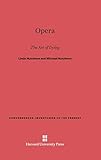Opera : The Art of Dying / Michael Hutcheon, Linda Hutcheon.
Material type: TextSeries: Convergences: Inventories of the Present ; 29Publisher: Cambridge, MA : Harvard University Press, [2013]Copyright date: ©2004Edition: Reprint 2014Description: 1 online resource (239 p.) : 10 halftonesContent type:
TextSeries: Convergences: Inventories of the Present ; 29Publisher: Cambridge, MA : Harvard University Press, [2013]Copyright date: ©2004Edition: Reprint 2014Description: 1 online resource (239 p.) : 10 halftonesContent type: - 9780674335615
- 9780674335639
- 782.1
- online - DeGruyter
| Item type | Current library | Call number | URL | Status | Notes | Barcode | |
|---|---|---|---|---|---|---|---|
 eBook
eBook
|
Biblioteca "Angelicum" Pont. Univ. S.Tommaso d'Aquino Nuvola online | online - DeGruyter (Browse shelf(Opens below)) | Online access | Not for loan (Accesso limitato) | Accesso per gli utenti autorizzati / Access for authorized users | (dgr)9780674335639 |
Frontmatter -- Contents -- Illustrations -- Introduction Music and "Murky Death" -- 1. The Contemplation of Death -- 2. Eros and Thanatos Richard Wagner's Tristan und Isolde -- 3. “All That Is, Ends” Living while Dying in Wagner’s Der Ring des Nibelungen -- 4. Orphic Rituals of Bereavement -- 5. “’Tis a Consummation Devoutly to Be Wish’d” Staging Suicide -- 6. The Undead -- Coda “Be Acquainted with Death Betimes...” -- Notes -- Acknowledgments -- Index -- Backmatter
restricted access online access with authorization star
http://purl.org/coar/access_right/c_16ec
Our modern narratives of science and technology can only go so far in teaching us about the death that we must all finally face. Can an act of the imagination, in the form of opera, take us the rest of the way? Might opera, an art form steeped in death, teach us how to die, as this provocative work suggests? In Opera: The Art of Dying a physician and a literary theorist bring together scientific and humanistic perspectives on the lessons on living and dying that this extravagant and seemingly artificial art imparts. Contrasting the experience of mortality in opera to that in tragedy, the Hutcheons find a more apt analogy in the medieval custom of contemplatio mortis--a dramatized exercise in imagining one's own death that prepared one for the inevitable end and helped one enjoy the life that remained. From the perspective of a contemporary audience, they explore concepts of mortality embodied in both the common and the more obscure operatic repertoire: the terror of death (in Poulenc's Dialogues of the Carmelites); the longing for death (in Wagner's Tristan and Isolde); preparation for the good death (in Wagner's Ring of the Nibelung); and suicide (in Puccini's Madama Butterfly). In works by Janacek, Ullmann, Berg, and Britten, among others, the Hutcheons examine how death is made to feel logical and even right morally, psychologically, and artistically--how, in the art of opera, we rehearse death in order to give life meaning.
Mode of access: Internet via World Wide Web.
In English.
Description based on online resource; title from PDF title page (publisher's Web site, viewed 30. Aug 2021)


